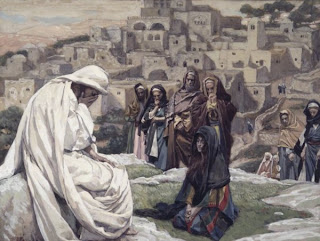The Savior's Final Week in Mortality
This weeks assignment I chose to study each day in the week proceeding Christ resurrection. the following summary was obtained from the Institute Manual "The Life and the Teachings of Jesus and His Apostles", section 5, p. 135-137.
Day 1:
Jesus arrived at Jerusalem. He rides through the city gates into Jerusalem on a donley. A multitude placed palm branches in his way and greeted him with a hosanna shout:“Hosanna to the Son of David: Blessed is he that cometh in the name of the Lord; Hosanna in the highest.” (Matthew 21:9.)
Day 2:
Early the next morning Jesus went to the temple and challenged the Jewish religious leadership. He drove the money exchangers. The money exchange was apparently sanctioned by the Jewish leaders; and by preventing the merchandizing, Jesus was in effect challenging their leadership. He asked if the temple is a place of worship of God or of pursuit of gain? As he cleared the temple courts, he said, “It is written, My house shall be called the house of prayer; but ye have made it a den of thieves.” (Matthew 21:13.) That night, Jesus returned to Bethany.
Day 3:
Jesus’ wrath in the temple raised the issue of authority, and the priests were not about to let the incident pass. As Jesus came to the temple the next day, the priests challenged him: “By what authority doest thou thesethings? and who gave thee this authority?” (Matthew 21:23.) Jesus responded by relating a series of parables that offended the religious leaders of the Jews. The scribes and Pharisees challenged him again; Jesus openly denounced them and condemned them as
hypocrites. From this point on, Jesus did not teach the public, but only the Twelve.
The Jewish leaders perceived that Jesus had gained the upper hand in their confrontations, so they consulted again how they might bring about Jesus’ death. They would have to move quickly before the Passover to avoid a riot, however, since Jesus had become very popular with the Jewish people. How to bring about an arrest without provoking crowd reaction was the problem. An unexpected turn of events that took place abetted their plot. One of Jesus’ own disciples offered to betray him.
Day 4:
Jesus well knew of the plot. The fourth day was spent outside the city, perhaps at Bethany. The record of the gospel writers is silent on the proceedings of this day. This picture depicts Christ weeping over the people in Jerusalem while staying in Bethany.
Day 5:
Jesus had arranged to commemorate the Passover meal in a home privately reserved for him and the
Twelve. Following the Passover meal, Jesus introduced a new ordinance, the sacrament, which
presaged his atoning sacrifice. He then prophesied of his death and indicated who would betray him.
After some instructions, Jesus offered his great intercessory prayer.
Then, with the eleven (Judas had left), Jesus led them outside the walls
to a familiar spot—Gethsemane. Then taking Peter, James, and John with him, he went further into the Garden where he then left those
three and went off by himself to pray. (See Matthew 26:36–39.) There he
pled with his Heavenly Father to “let this cup pass from me:
nevertheless not as I will, but as thou wilt.” (Matthew 26:39.) The cup
did not pass and Jesus suffered “the pain of all men” (D&C 18:11),
an agony so excruciating that it caused him to bleed at every pore
(D&C 19:18).
Some time later he rejoined his apostles and indicated
that his betrayer was at hand. While he spoke, an armed band led by
Judas approached Jesus to seize him. Without resistance Jesus submitted.
Jesus was brought to an illegal trial that night.
Day 6:
The Jewish leaders now faced another problem. They were not content that Jesus should be put to death; they also wanted to discredit him before his own people. To do this, the leaders arranged to have Jesus charged with two crimes. The first was blasphemy, a capital offense under Jewish law. He was unanimously convicted of this charge solely on the evidence that he had said that he was the Son of God. (See Matthew 26:57–66.) Such a conviction would discredit Jesus before the Jews, but the rulers knew well that they could not carry out the death penalty; only the Roman governor could pronounce this. Therefore, they had to find political indictment against Jesus. The surest means of securing this was the charge of sedition against the state, for he had claimed to be a “king of the Jews.” Though Pilate’s examination found Jesus guiltless of the charge, the Jewish leaders had incited
the crowd to “destroy Jesus.” (Matthew 27:20.) Fearing a demonstration, Pilate gave in to the clamor
to crucify Jesus, and the death sentence was pronounced.
And so Jesus was executed by the brutal Roman practice of crucifixion.
Later that afternoon he voluntarily gave up his spirit. The next day,
which began at sundown, was the Passover, and the Jewish leaders
abhorred the idea that a man should remain on a cross on the Sabbath,
particularly the paschal Sabbath. Before nightfall, Jesus’ body was
removed from the cross and buried in a sealed tomb by two revering
disciples.
Day 7:
This was the Jewish Sabbath. Jesus’ body remained in the tomb, but in spirit he ministered in the realm of departed spirits. (See 1 Peter 3:18–20.)
Day 8:
Jesus Christ emerged alive from the tomb, and appeared before Mary. “These are written, that ye might believe that Jesus is the Christ, the son of God; and that believing ye might have life through his name.” (John 20:31.)













